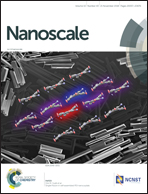A bio-inspired physically transient/biodegradable synapse for security neuromorphic computing based on memristors†
Abstract
Physically transient electronic devices that can disappear on demand have great application prospects in the field of information security, implantable biomedical systems, and environment friendly electronics. On the other hand, the memristor-based artificial synapse is a promising candidate for new generation neuromorphic computing systems in artificial intelligence applications. Therefore, a physically transient synapse based on memristors is highly desirable for security neuromorphic computing and bio-integrated systems. Here, this is the first presentation of fully degradable biomimetic synaptic devices based on a W/MgO/ZnO/Mo memristor on a silk protein substrate, which show remarkable information storage and synaptic characteristics including long-term potentiation (LTP), long-term depression (LTD) and spike timing dependent plasticity (STDP) behaviors. Moreover, to emulate the apoptotic process of biological neurons, the transient synapse devices can be dissolved completely in phosphate-buffered saline solution (PBS) or deionized (DI) water in 7 min. This work opens the route to security neuromorphic computing for smart security and defense electronic systems, as well as for neuro-medicine and implantable electronic systems.



 Please wait while we load your content...
Please wait while we load your content...